
2015 Note: After our awesome 2014 experience documented below, we returned to Master Tech RV in Summer 2015 for a new paint job, hydronics installation, generator swap out and other projects. This time, after a year of getting to know Tim better across the country, we’d be dropping our bus/RV off for 6-8 weeks while we went to Alaska for a much needed vacation. We went through a lot of scheduling & planning to coordinate our trip to match Master Tech’s stated availability.
We had a mixed experience this time around. While we were gone, Master Tech got very little work done with minimal communication, over-stated progress and damage done to our RV (which their insurance covered).
Our project which had been promised to be ready by mid to late July when we returned from Alaska, required us moving onsite in early August to be directly involved on a daily basis as there was little project management provided. They did kick it into gear once we were there, with Tim (the owner) working nights & weekends with us – and we were out of the shop with most items completed on September 15 (6 weeks past due). The work was done well (some exceptionally well) – but the delays, and needing to be intimately involved 8-16 hours a day for a month, did impact our lives substantially.
For the full story – check out all of our Master Tech RV posts.
Sometime last month we got an e-mail from a guy named Kasey, who said he was in the Elkhart area getting some work done on his coach. He mentioned that he had gotten turned on to Victron inverters thanks to discovering our blog, and he would like to meet up if it was possible while we were also in the area.
Sure, we love meeting people – especially other RV tech geeks!
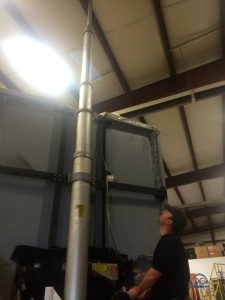
We quickly learned that ‘getting some work done’ was a huge understatement – Kasey and his girlfriend Amber were in the middle of a complete gutting and over-the-top remodel of their rig that they were having done at Master Tech RV. They had actually been living there for most of the past year working on creating what will be one of the most ridiculously geeked out RVs ever, once it is finished.
It is rare that I get blown away by someone else’s tech upgrades – but Kasey’s 65′ surplus TV news truck retractable antenna mast left us with major tech envy.
And that was just the start of it.
Master Tech RV happened to be one of the service centers we had contacted on our way into Elkhart to see if they might be up for tackling some of our bus projects, but having been swamped with other urgent tasks, we had not yet committed to get on their schedule.
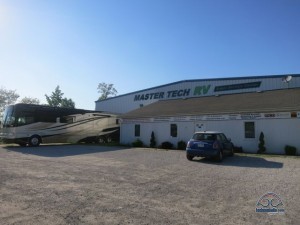
Though our pending-project list is always pages long, the one urgent fix we wanted some professional help with was getting the inversion valve that blew out on our way into Memphis more securely mounted to the bus rear bulkhead. Even though it had taken the previous valve decades to fail, we didn’t want to take any chances with our air brake system.
Working on the inversion valve required access to a pit, run-up ramps, or a lift – so it was something we needed a shop’s help to tackle. We also wanted to inspect the entire air system to see if there were any other lurking problems.
As usual – serendipity aligned everything for us. By coming over to meet Kasey and Amber, we got introduced to the owner of Master Tech RV – Tim, and his son Austin. It was a pretty instant connection all the way around.
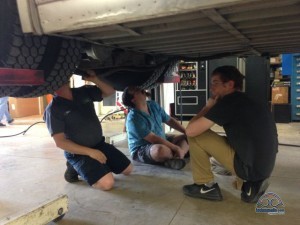
After a harsh winter in Indiana, all of the shops in Elkhart are experiencing a very busy season with RVers wanting spring and summer work done. Getting into a shop last minute was going to be a bit difficult. But Tim invited us to come stay at Master Tech’s onsite campground after we had our seats installed at Bradd and Hall, and if we were willing to be flexible – he’d work us into the shop as soon as he could.
This was fine by us, and gave us a place to hang out for a few days, and the opportunity to spend more time with Kasey and Amber too.
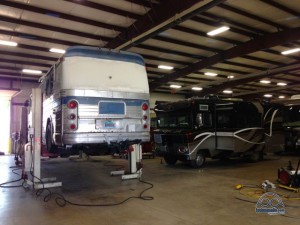
On Friday afternoon, we had a knock on the door that the shop could get us in – so we moved the bus into the bay and they got us up on their lift system to get at the air valve. Our tech fabricated a new mount to hold the valve securely to the bulkhead, and we also did a few more safety and leak related tweaks to the air system.
The crew had to go home, but Tim was going to be working all weekend long, and late into every night, on his awesome 1974 Winnebago Brave that has been his passion project for years – getting it ready to show off at the upcoming Fleetwood / Glamarama rally where Master Tech will be exhibiting.
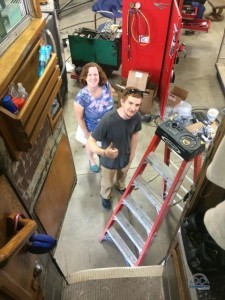
Tim invited us to be his neighbor in the shop, and said we could make use of the lift, his tools, and tap into his expertise if we wanted to tackle any other projects on the bus on our own.
That’s an offer that just doesn’t come around every day – so we decided to take full advantage of it!
Austin then sweetened the deal by giving us the access codes to get us onto the super-fast WiFi, and allowing us to use AirPlay to control the shop’s rocking sound system from our iPhones. Before becoming a master RV tech, Tim was a professional DJ – so this shop has a super impressive sound system.
It was shaping up to be an awesome weekend of intense bus projects while rocking out!
Now.. what projects to tackle?? The list is so long!
Project 1: Suppressing our Surges
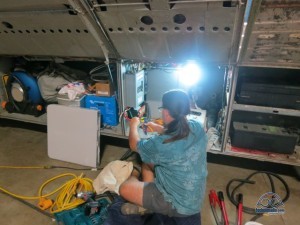
Our plug-in 30A surge protector had recently bit the dust after many years of service, and we’ve been carrying around an inline TRC Surge Guard 50A protector that our friends Forrest and Mary had gifted us from their spare parts bin, waiting for a good opportunity to install it.
Friday night’s project was redoing the bus shore power input to pass through the surge suppressor – meaning that I now no longer need to go unplug us from the pedestal when lightening storms are in the area.
Tip: We consider a full-rig surge protector to be an essential piece of RVing gear if you plug in to shore power and are concerned about your electronics!
Project 2: Strutting Our Stuff
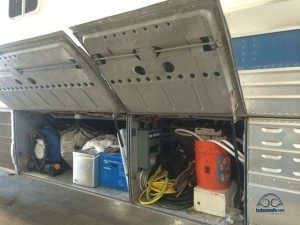
The pneumatic strut that holds open the bay door over our utility bay has never been strong enough to hold up the door on its own. Back when we first got the bus I tried three separate times to find a more appropriate strut – but gave up in frustration dealing with auto part stores that can’t look up parts by spec, but only by “what year, make, and model”.
I asked Tim for advice on where to buy an appropriately sized stronger strut – and he grabbed his parts bin before I could even finish describing the problem. “Let’s try 150lbs. Nope, way too strong. 80lbs – nope, too weak. 100lbs – yes, just right!”
For the first time ever – I was now able to work in the utility bay without needing a pipe to hold open the door! Wahoo!
Project 3: Taking it to the Rear
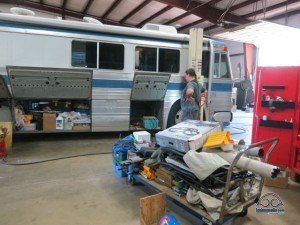
When we first installed the lithium battery system and inverter, we located it way up in the front bay – requiring a very long wire run all the way forward from the utility bay, and then all the way back to the circuit breaker panel.
This was an especially long run for the DC power to flow when we wanted to charge the batteries or run the roof air-conditioning using power from the alternator, and we were taking advantage of some old bus wiring and a chassis ground to enable this – but the DC wiring was far from ideal.
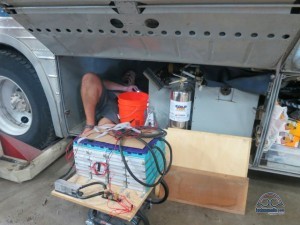
At the time we had no choice – the back bay was still occupied with a giant 50 gallon propane tank. But we long ago went propane free, and that back half of the utility bay had become just a hard-to-access junk and spare parts storage area.
We’ve long wanted to relocate the batteries and inverter there, beef up the wiring that ties into the alternator, and in general improve the electrical installation.
At last – we had the perfect opportunity!
But… What a big job!
It essentially involved dismantling and rebuilding our entire bus electrical system, and it took two full marathon days and nights. Fortunately we had Tim around to tap into for occasional advice and tools – his giant crimper and coaching helped us make easy work of making the new 0/4 cables we needed, among many other things.
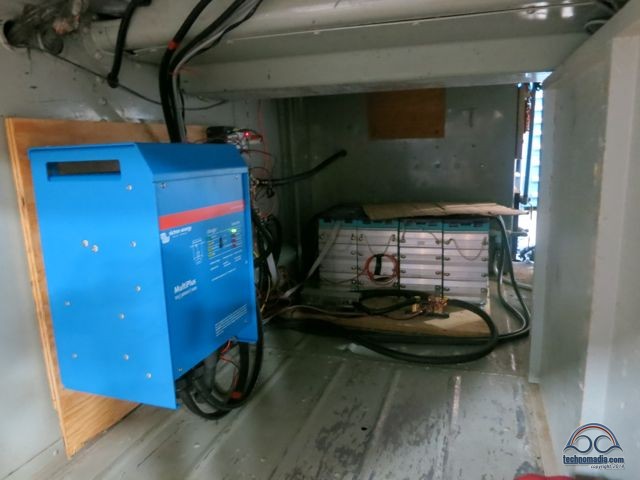
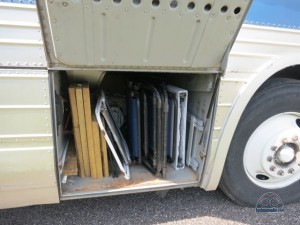
By early Monday morning when we finally powered everything back up my arms were jello, my fingers bloody, and I could barely utter a coherent sentence. But we pulled it off, and the install looks great.
We are also now ready for mounting a solar controller, and I even sized the battery chamber to allow for an eventual upgrade to a larger lithium ion battery bank. (The new 1250Ah Balqon cells have our eye!)
The next big electrical upgrade? Solar! We’re deep in research choosing our flexible panels.
We then took the empty front bay, and turned it into a perfect storage area for all our outside furniture.
More Info: Lithium Ion Batteries for RVs
Project 4: The Annoying Anode
Even us seasoned RV’ers occasionally overlook seasonal maintenance, and it had dawned on us that we had gone two years since installing a new anode into our water heater.
Yikes!
It took an oversized breaking bar to get the corroded old one loose, and it was indeed LONG overdue for a change.
But we got this chore tackled too.
REMINDER: If you have a steel water heater (Suburban, etc) in your RV – change the anode EVERY year!
Project 5: Waking Up Horny
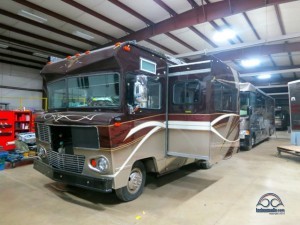
Late Sunday Tim was showing off the air horn on his Winnie, and not to be outdone I hit the bus air horn.
It roared to life, but…. It didn’t stop! The horn was stuck, roaring away until I pulled an air system release valve and drained all the air away. Yikes! I saturated the stuck horn valve in chain lube, and hoped that it would unstick by morning.
7AM Monday morning we had to be ready for the main work crew to check over a few final air system leaks, and then to get out of the bay and off the lift so the regularly scheduled work could continue.
When directed – I fired up the bus, and as air pressure built…. The rising sound of the horn gave everyone a very exciting wakeup call, echoing through the entire shop! The horn was still stuck – whoops!
Some saturating with PB Blaster into the valve eventually got it unstuck and back to smooth operation, and we were soon done in the shop and relocated back to the campground.
Thank you Master Tech RV – it was an absolute pleasure being here, and getting so much done. You rock our world, and we look forward to returning!
And after having spent some time getting to know the owner, the crew, and many of Master Tech’s customers – we can highly endorse this shop for any of your RVing repair, renovation, or advancement needs.

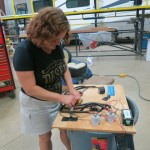
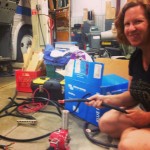
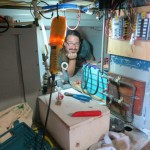
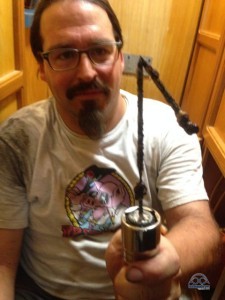
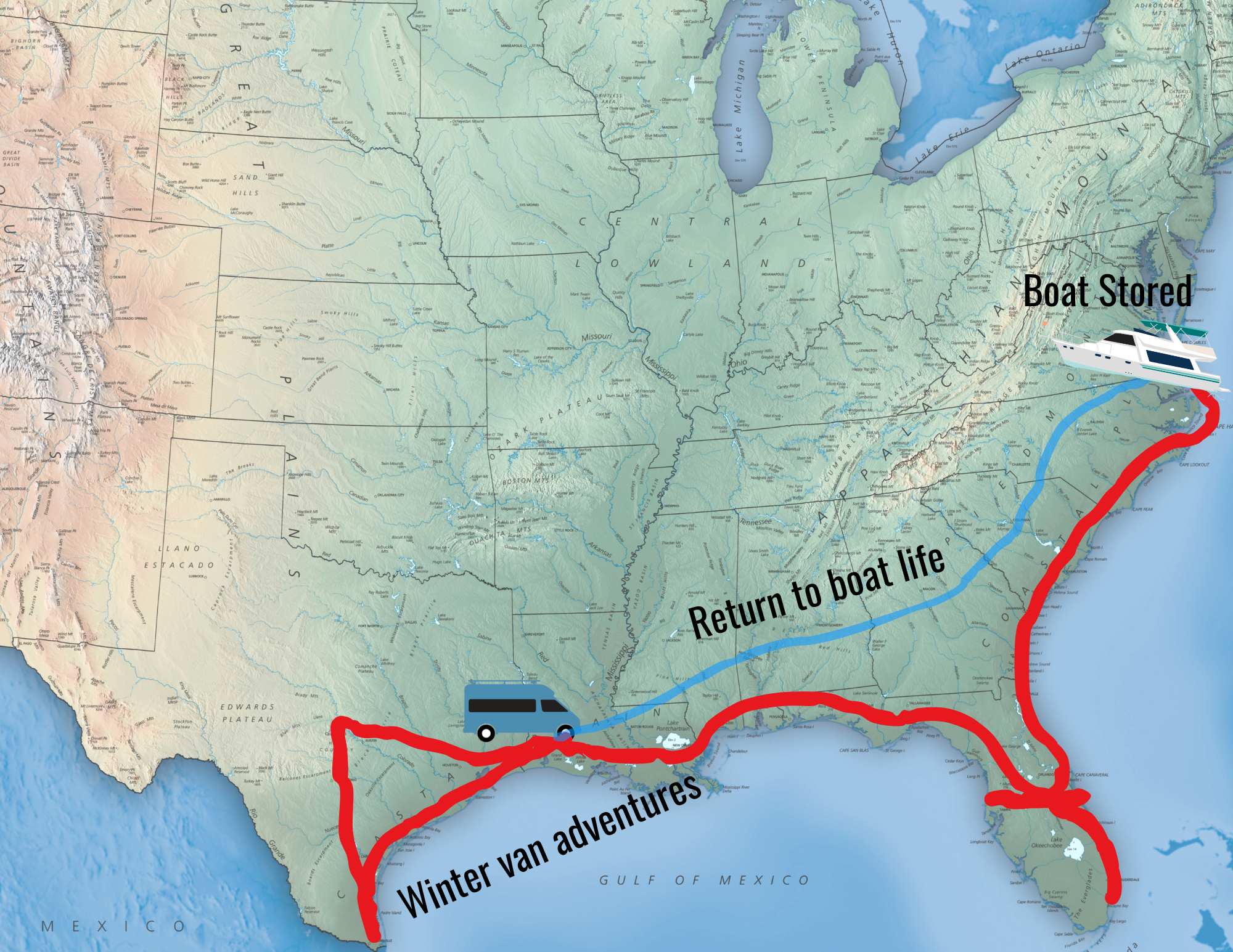
guess you have been on lithom now for about 3 years. Wonder what your views are, and what type of monitoring do you do? I am a live abord boater and am in the process now of building a electric 12 ft boat . want to use lifepo4 for batteries and also use the boat as a solar generator with a 3000 pure sine inverter. In my limited research seems just bottom balancing the new cells(which sets all the cells lower end ) then protecting against over voltage charge maybe operating them in the 20% to 90% capacity range would be sufficient without need for BMS. Think as I have read that at times those additional circuits are causing some electrical fires and are more geared to the massive current draws of EV’s.. Just wondering your thoughts this far in . Cheers Ken
PS in the dinghy/generator setup will be using 12 200 amp cells for a 36 volt system using 600 watts solar and a midnite solar the kid mptt controller. This would equal the capacity of around 12 t105 batteries.
Hi Ken.. you can find our entire series on lithium at https://www.technomadia.com/lithium – we did an overview of them last year in a video. When we have time, we’ll update with anything new and relevant. Thanks!
We stopped at Master Tech last fall to have our dead Norcold removed and replaced with a residential refrigerator. We had a bit of trouble finding a suitable replacement until I stumbled upon a 25CF Samsung at Lowe’s. When I talked to Joe I mentioned that it was 2″ too wide. His response – “no problem, we’ll just move the wall”. He did, and the installation was incredible – looks like it came from the factory, maybe better. Can’t say enough about the service and professionalism.
I’ve checked out Tim’s ’74 brave, and it’s STUNNING! I’ve always considered that model (which I encountered in person first at the Winnie Visitor’s Center in FC, IA) to be soooooo butt ugly that it wraps the meter’s dial back around to beautiful! I love that he’s giving it a new life, and would love to do the same myself someday!
I think I must have come across Balqon batteries from your lithium battery discussion (thanks for all the info!). Just curious – I’m prepping for my solar install and only have space for two 12V batteries in my short Class C. That gives me 230Ah to work with for about $343 with the batteries I have my eye on (although my current batteries aren’t shot, so I’m going to wait to replace them until I get the system all dialed in, etc.).
Alternatively, I was looking at the Balqon 200Ah and 260Ah LFP batteries. I believe I could fit 4-5 of these batteries in my battery box and end up with 800Ah to 1300Ah for $880 to $1390, respectively. So, that means 230Ah Lead Acid would be $1.49/Ah and LFP would be in the $1.10/Ah range and have significantly more capacity. I note they also suggest LFP’s can withstand a greater depth of discharge providing even more usable Ah’s. Would you agree with that? I’ve heard the same said about AGM, but it seems not everyone agrees.
My concerns is that I thought I read something on Balqon’s site about the LFP’s not being able to be charged below freezing. Of course, I can’t seem to find that spec sheet on their site at the moment. Do you know anything about this? I don’t necessarily winter camp, but I do live in CO and tend to camp in the fall when weather is cooler and wouldn’t want to have to worry about “breaking” the battery bank I spent $1K on…
Allie —
I think you might be confusing “cell” with “battery” — the Balqon cells that I’ve referenced are 3.2V nominal. It takes four cells combined to make a 12V battery that can be used as an RV house battery bank.
But yes – if you check our posts under https://www.technomadia.com/lithium – you will see the details on how LFP batteries can be generally discharged much deeper than flooded lead.
As for charging below freezing — I haven’t double-checked the specs on Balqon, but I do know some LFP batteries do not like to be charged when that cold. Some LFP systems actually wrap that battery in a heating blanket to compensate.
Do your research and make sure you know what you are getting into.
Good luck!
– Chris
>Alternatively, I was looking at the Balqon 200Ah and 260Ah LFP batteries. I believe I could fit 4-5 of these batteries in my battery box and end up with 800Ah to 1300Ah for $880 to $1390, respectively.
In other words… it would take 4 of the 3.2v 200AH cells to make a 12v 200 AH battery, at a cell cost of $880. You also need to factor in costs of wiring, fuses, and battery management system to completely your battery construction.
If you want to go to Nappanee while you are out there, we had a fabulous solar install from SES Solar Energy Systems LLC — you have to be careful when you google the name, sometimes another company altogether comes up! The brains and owner of the outfit is a young-ish Amish fellow and he is solar brilliant! His crew is super — efficient, friendly and good at what they do. We had originally just thought we would have them give us an estimate, but it turned out that the other work we were having done on our bus had a few days in between jobs, and we decided not to wait. You might just go see them….and get some info, etc. We are very happy with the work and the installation.
Nice job Chris and Cherie! It is so much easier to do things yourself when you have those special tools at your disposal.
Oh gawd! More Star Wars fans! Gah! (kidding).
And AT-AT bus would be awesome though, wouldn’t it?
I’d love to be able to stomp into tricky campsites, but I would always be worrying about snow-speeders tripping me up!
*grin*
We have been to master tech with our tiffin coach in 2012 we had some issues that no one could find. but they did there tech Joe found our problem and it’s been smooth sailing ever thence .
Love master tech
don
Great information, Chris! Thank you. I hope that they are still around (sounds as though they surely will) when we get around to RVing.
Congrats, always fun to spruce things up.
super cool updates! Love it!
glad to see the bus getting her upgrades. makes life easier and safer. very clever headlines! i intend on doing a retrofit of our mh before going full time.
Super impressed with all the updates. Looking great!
Nina